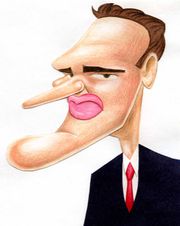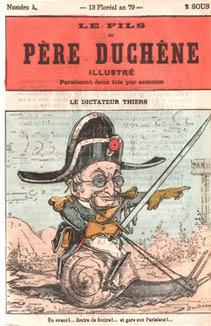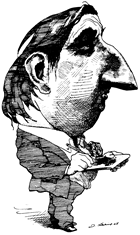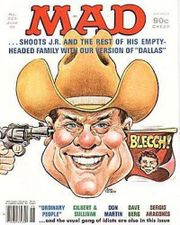Caricature
From Wikipedia, the free encyclopedia



A caricature is a portrait that exaggerates or distorts the essence of a person or thing to create an easily identifiable visual likeness. Caricatures can be insulting or complimentary and can serve a political purpose or be drawn solely for entertainment. Caricatures of politicians are commonly used in editorial cartoons, while caricatures of movie stars are often found in entertainment magazines.
An early definition of the origins of 'caricature', an Italian word meaning 'to load', occurs in the English doctor Sir Thomas Browne's Christian Morals (first pub.1716).
- Expose not thy self by four-footed manners unto monstrous draughts, and Caricatura representations.
with the footnote —
- When Men's faces are drawn with resemblance to some other Animals, the Italians call it, to be drawn in Caricatura
Thus, the word "caricature" essentially means a "loaded portrait". According to caricature teacher Sam Viviano, who stressed this definition of the term in the classes he taught at the School of Visual Arts in New York City, the term refers only to depictions of real-life people, and not to cartoon fabrications of fictional characters, which do not possess objective sets of physiognomic features to draw upon for reference, or to anthropomorphic depictions of inanimate objects such as automobiles or coffee mugs. Walt Disney on the other hand, equated his animation to caricature, saying the hardest thing to do was find the caricature of an animal that worked best as a human-like character.
Contents |
[edit] History

Some of the earliest caricatures are found in the works of Leonardo da Vinci, who actively sought people with deformities to use as models.
The inventor of caricature as an independent art form was, according to seventeenth century sources, the Bolognese history painter, Annibale Carracci. A writer calling himself Mosini recorded Annibale's 'theory' of caricature as being the ultimate antithesis of beauty: 'una bella... perfetta deformità.' Like beauty in art, Annibale held, it was based on selection and synthesis. The artist was to devise it, in a playful spirit like that of Nature, whenever She offered him suitable models. The point was to offer an impression of the original which was more striking than a portrait. Gianlorenzo Bernini (1598-1680), one of the great early practitioners, was favored by the members of the papal court for his ability to depict the essence of a person in 'three or four strokes.'(In fact, the word caricature comes from the Italian caricare, "to load," i.e., the caricaturist's aim is to invest his image with as much meaning as possible.)
Caricature, therefore, experienced its first successes in the closed aristocratic circles of France and Italy, where the such portraits could be passed about for mutual enjoyment which many people enjoyed.

This aura of privilege (for both those depicted and those viewing the caricature) passed on to England during the middle of the 18th century, when caricature enjoyed its first wave of popularity there. The first book on caricature drawing to be published in England was Mary Darly's A Book of Caricaturas (c. 1762). Probably the greatest practitioner of the art of caricature in 18th-century Britain was James Gillray(1757-1815). See the Tate Gallery's exhibit James Gillray: The Art of Caricature
The art form gained further popularity in the early 19th century, when satirical drawings of politicians and local celebrities would be printed in newspapers. Caricatures would often be less than warmly received by their powerful targets, and for many years the art form was one of anonymous mischief.

by André Gill
Hand-colored engraving published in L'Eclipse newspaper, June 14, 1868
Dickens crosses the English Channel, carrying his books from London to Paris.
In the years after World War I the art form experienced a renaissance in the United States, and in some magazines caricatures became more common and in higher demand than actual photographs. A new wave of artists like Al Hirschfeld and Miguel Covarrubias showed that caricatures could be fun, colorful, and graceful, and not always the crude, vicious insults found on the editorial page. In the UK Punch magazine kept the tradition alive through the 1950 to 1980 period. The cartoonist Steve Bell maintained the tradition thereafter to great effect. The puppet show Spitting Image on British television during the 1980s brought an awareness of caricature to a new generation, combining rod-operated puppets with accurate vocal impressions. Politicians, media stars and sporting celebrities remained the main targets and the grey finish of a much used John Major puppet played a very significant role in establishing his unadventurous public image in the UK.
Today, the art of caricature is still around, though nowhere near as prevalent as the "Golden Age" of the 20's and 30's. In recent years there has been a rise of amateur "On-the-spot Caricaturists" who can be found on street corners or fairs and will draw a quick sketch of anyone willing to pay their fee. There are also those who draw caricatures from photos submitted over the internet.
[edit] Notable caricaturists
George Cruikshank (1792-1878, British) created political prints that attacked the royal family and leading politicians (in 1820 he received a royal bribe of £100 for a pledge "not to caricature His Majesty (George III of the United Kingdom) in any immoral situation ." He went on to create social caricatures of British life for popular publications such as The Comic Almanack (1835-1853) and Omnibus (1842). He also earned fame as a book illustrator for Charles Dickens and many other authors.
Honoré Daumier (1808-1879, French) is considered by some to be the father of caricature. During his life, he created over 4,000 lithographs, most of them caricatures on political, social and everyday themes. They were published in the daily French newspapers (Le Charivari, La Caricature etc.)
Thomas Nast (1840-1902, American) was a famous caricaturist and editorial cartoonist in the 19th century and is considered by some to be the father of American political cartooning. He is often credited with creating the definitive caricatures of the Democratic Donkey, the Republican Elephant and Santa Claus.
Al Hirschfeld (1903 –
2003, American) was best known for his simple black and white renditions of
celebrities and Broadway stars which
utilized flowing contour lines over heavy rendering. He was also known for
depicting a variety of other famous people, from politicians musicians, singers
and even television stars like the cast of Star Trek:
The Next Generation. He has was even commissioned by the United States
Postal Service to provide art for U.S. stamps. Permanent collections of
Hirschfeld's work appear at the Metropolitan
Museum of Art and the Museum of Modern
Art in New York, and he boasts a star on the St. Louis Walk of
Fame.
Mort Drucker (1929 - ,
American) Drucker joined Mad magazine in 1957
and has become well known (and revered by some) for his brilliant parodies of movies and television shows. He
manages to combine a comic strip style with
consistent photographic likenesses of film and TV stars panel after panel. He
has also contributed covers to Time magazine. He
has been recognized for his work with the National
Cartoonist Society Special Features Award for 1985, 1986, 1987, and 1988,
and their Reuben Award for 1987.
Robert Risko (1946 – ,
American) is known for his retro airbrush style. His work has
appeared in Rolling Stone, Playboy, Vanity
Fair, Esquire, and
Interview.
David Levine (1926 – , American) is noted for his caricatures in the The New York Review of Books and Playboy magazine.. His first cartoons appeared in 1963. Since then he has drawn hundreds of pen-and-ink caricatures of famous writers and politicians for the newspaper.
Sam Viviano (1953 – , American) has done much work for corporations and in advertising, having contributed to Rolling Stone Family Weekly, Reader's Digest, Consumer Reports, and Mad, of which he is currently the art director. Viviano’s caricatures are known for their wide jaws, which Viviano has explained is a result of his incorporation of side views as well as front views into his distortions of the human face. He has also developed a reputation for his ability to do crowd scenes. Explaining his twice-yearly covers for Institutional Investor magazine, Viviano has said that his upper limit is sixty caricatures in nine days.
Sebastian Kruger
(1963 – , German) is known for his
grotesque, yet hyper-realistic distortions
of the facial features of celebrities, which he renders primarily in acrylic
paint, and for which he has won praise from The Times. He is well
known for his lifelike depictions of The Rolling Stones,
in particular, Keith Richards. Kruger
has published three collections of his works, and has a yearly art calendar from
Morpheus International. Kruger's art can be seen frequently in Playboy
magazine and has also been featured in the likes of Stern, L’Espresso,
Penthouse, and
Der
Spiegel and USA Today. He has recently
been working on select motion picture projects.
Hermann Mejia (Venezuelan) is
known for his frequent work for MAD Magazine. Mejia
uses multiple techniques for his work, sometimes rendering his illustrations in
black & white ink and copious amounts of cross-hatching, sometimes
using watercolor, and sometimes
combinations of both.
Jan
Op De Beeck has published several books on caricature and was named
"World's Best Caricaturist" in 2003 by a group of professional cartoonists in
Iran.
[edit] See also
[edit] References
The Complete Book of Caricature by Bob Staake
[edit] External links
- National Caricaturist Network Official site
- Jan Op De Beeck Official site
- David O'Keefe Official site
- Honoré Daumier site with a list of exhibitions and bibliography.
- Kaman's Art Shoppes America's Largest Amusement and Theme Park Concessionaire.
- Caricatures Caricatures in different styles
- Digital caricatures the next generation of caricature media
- Caricatures by Kerry Kerry G. Johnson
- Allan Cavanagh Arts Allan Cavanagh
- Using editorial cartoons in the classroom Sources, analysis, interpretation (mostly English with some German)
- [1]Digital and analogue caricatures.









